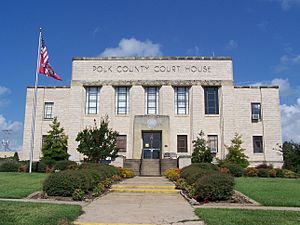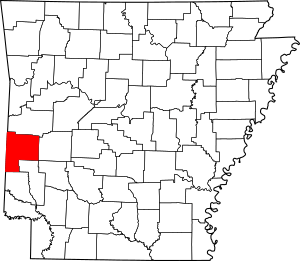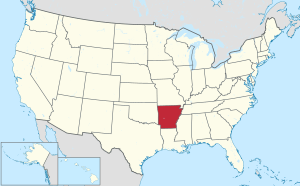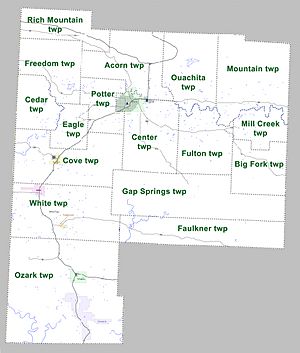Polk County, Arkansas facts for kids
Quick facts for kids
Polk County
|
|
|---|---|

Polk County Courthouse in Mena
|
|

Location within the U.S. state of Arkansas
|
|
 Arkansas's location within the U.S. |
|
| Country | |
| State | |
| Founded | November 30, 1844 |
| Named for | James K. Polk |
| Seat | Mena |
| Largest city | Mena |
| Area | |
| • Total | 862 sq mi (2,230 km2) |
| • Land | 858 sq mi (2,220 km2) |
| • Water | 4.8 sq mi (12 km2) 0.6%% |
| Population
(2020)
|
|
| • Total | 19,221 |
| • Estimate
(2023)
|
19,436 |
| • Density | 22.298/sq mi (8.609/km2) |
| Time zone | UTC−6 (Central) |
| • Summer (DST) | UTC−5 (CDT) |
| Congressional district | 4th |
Polk County is a county located in the U.S. state of Arkansas. In 2020, about 19,221 people lived here. The main town and county seat is Mena.
Polk County became Arkansas's 48th county on November 30, 1844. It was named after James K. Polk, who was the 11th President of the United States.
Contents
What is a Wet County?
For a long time, Polk County was a "dry county." This meant that selling alcohol was not allowed. However, after a special election, Polk County is now a "wet county." This means that alcohol can be sold legally within the county.
Exploring Polk County's Geography
Polk County covers a total area of about 862 square miles. Most of this area, about 858 square miles, is land. The remaining 4.8 square miles (which is about 0.6%) is water.
Main Roads and Highways
Many important roads run through Polk County. These highways help people travel and connect different communities.
 Future Interstate 49
Future Interstate 49 U.S. Highway 59
U.S. Highway 59 U.S. Highway 71
U.S. Highway 71 U.S. Highway 270
U.S. Highway 270 U.S. Highway 278
U.S. Highway 278 Highway 4
Highway 4 Highway 8
Highway 8 Highway 84
Highway 84 Highway 88
Highway 88
Public Transportation
For those who need to travel by bus, Jefferson Lines offers service in the area.
Neighboring Counties
Polk County shares its borders with several other counties. These include:
- Scott County (to the north)
- Montgomery County (to the east)
- Pike County (to the southeast)
- Howard County (also to the southeast)
- Sevier County (to the south)
- McCurtain County, Oklahoma (to the southwest)
- Le Flore County, Oklahoma (to the northwest)
Protected Natural Areas
Part of the Ouachita National Forest is located within Polk County. This forest is a large protected area known for its natural beauty.
Population and People
The number of people living in Polk County has changed over the years. Here's how the population has grown and shrunk:
| Historical population | |||
|---|---|---|---|
| Census | Pop. | %± | |
| 1850 | 1,263 | — | |
| 1860 | 4,262 | 237.5% | |
| 1870 | 3,376 | −20.8% | |
| 1880 | 5,857 | 73.5% | |
| 1890 | 9,283 | 58.5% | |
| 1900 | 18,352 | 97.7% | |
| 1910 | 17,216 | −6.2% | |
| 1920 | 16,412 | −4.7% | |
| 1930 | 14,857 | −9.5% | |
| 1940 | 15,832 | 6.6% | |
| 1950 | 14,182 | −10.4% | |
| 1960 | 11,981 | −15.5% | |
| 1970 | 13,297 | 11.0% | |
| 1980 | 17,007 | 27.9% | |
| 1990 | 17,347 | 2.0% | |
| 2000 | 20,229 | 16.6% | |
| 2010 | 20,662 | 2.1% | |
| 2020 | 19,221 | −7.0% | |
| 2023 (est.) | 19,436 | −5.9% | |
| U.S. Decennial Census 1790–1960 1900–1990 1990–2000 2010 |
|||
In 2020, the 2020 United States census counted 19,221 people living in Polk County. There were 8,243 households and 5,672 families. Most people identified as White (non-Hispanic).
Towns and Communities
Polk County is home to several cities, towns, and smaller communities.
Cities in Polk County
Towns in Polk County
Special Census Areas
These are places that are counted separately for the census but are not officially cities or towns:
Other Small Communities
County Townships
Counties in Arkansas are divided into smaller areas called townships. Here are the townships in Polk County: Townships in Arkansas are the divisions of a county. Each township includes unincorporated areas; some may have incorporated cities or towns within part of their boundaries. Arkansas townships have limited purposes in modern times. However, the United States Census does list Arkansas population based on townships (sometimes referred to as "county subdivisions" or "minor civil divisions"). Townships are also of value for historical purposes in terms of genealogical research. Each town or city is within one or more townships in an Arkansas county based on census maps and publications. The townships of Polk County are listed below; listed in parentheses are the cities, towns, and/or census-designated places that are fully or partially inside the township.
- Acorn (a small part of Mena is in this township)
- Big Fork
- Cedar
- Center (most of Mena is in this township)
- Cove (Hatfield is here)
- Eagle
- Faulkner
- Freedom
- Fulton
- Gap Springs
- Mill Creek
- Mountain
- Ouachita
- Ozark (Grannis and Wickes are here)
- Potter (a small part of Mena is in this township)
- Rich Mountain
- White (Cove and Vandervoort are here)
See also
 In Spanish: Condado de Polk (Arkansas) para niños
In Spanish: Condado de Polk (Arkansas) para niños



